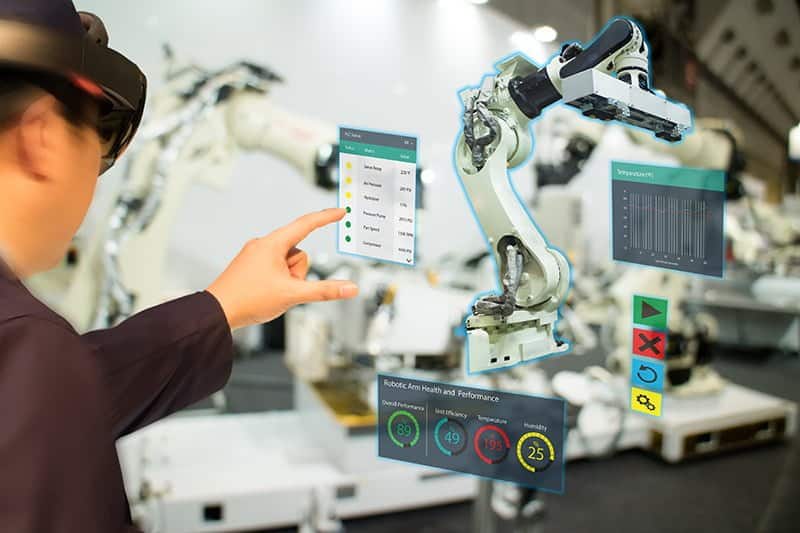Smart devices are here to stay and the market is growing along with the capabilities of these devices. The number of manufacturers who expect to dramatically increase the number of smart products they produce has grown exponentially in the past 4 years, and the trend looks set to continue.
A new report by Capgemini‘s Digital Transformation Institute reveals that the global manufacturing industry could expect to see between $519–$685 billion in value-added revenue by 2020 through the development and sale of smart devices.1 The report, “Digital Engineering: The new growth engine for discrete manufacturers” highlights that while the potential returns are significant, manufacturers need to invest in digital continuity and digital capabilities to benefit.
Manufacturers estimate that close to 50 percent of their products will be smart and connected by 2020, a 32 percentage point increase from 2014. In fact, 18 percent say that they plan to stop manufacturing products altogether and move to a pure service-based business model. A move in this direction will make the shift to a service-based model a business imperative and will require enhanced capabilities.
“We want to bring value to the market by shifting our business model toward service-based and cloud-connected architectures. It is a key way to differentiate our value proposition in the market of pure hardware players,” says Antoine Destribats, Vice President – Industrial Operations at Schneider Electric.
Manufacturers have responded enthusiastically to new technologies and are already rebalancing their IT investments accordingly. Around 50 percent of manufacturers aim to spend more than 100 million euros in Product Lifecycle Management (PLM) platforms and digital solutions in the next two years, while the proportion of IT budget earmarked for maintaining legacy systems has dropped significantly, from 76 percent in 2014 to 55 percent in 2017.
Unlocking the opportunity
While digital investment has increased substantially since 2014, few manufacturers have been able to scale their efforts. Two thirds (66 percent) acknowledge that they constantly face two competing priorities: accelerating time-to-market by maintaining continuous product innovation and development of legacy products versus investing in smart, connected products.
As a result of this tension, the use of model-based system engineering, data continuity, and virtual simulation within the industry is low; only 16 percent of organizations are fully implementing Digital Twins2 while 45 percent are not beyond the pilot stage. Similarly, despite being responsible for 58 percent of global research and development spend in 2017, less than one-in-five (19 percent) of discrete manufacturers featured in the Forbes’ list of the most innovative companies 2018, highlighting the ‘anchor’ effect of legacy products and the need to rethink current approaches to product and services innovation and engineering.
Investing in digital capabilities and a digital ecosystem will be key
If manufacturers are to capitalize on the smart devices opportunities, they will also need to improve on their IT and software skills competencies. According to the report, 86 percent of ‘novices’3 do not have the sufficient availability, within their current capabilities, for data management; 95 percent have insufficient skills for app design, and 94 percent for artificial intelligence. Outside hires will not fill the digital talent gap completely, states the report, which means that organizations will need to invest in digital training, tools and new collaborative ways of working for their existing employees. In parallel, developing an extended digital ecosystem will be key to design and will provide new end-to-end services.
“We assess the competencies of our staff very frequently with an emphasis on digital skills,” says Jan Willem Ruisch, Senior Director – Head of Product Management at Signify (formerly Philips Lighting). “We develop and implement training programs to ensure we stay up to date with the latest technologies.”
Manufacturers are struggling to tap data from products and customers to drive innovation
Manufacturers will also need to capitalize on the data generated by smart devices in their transition to selling services. Usage of data from connected products, as well as customer feedback from social channels, is increasingly replacing traditional market surveys to fuel product and service innovation.
Despite the growing importance of data and the technology through which it is garnered, the report finds that only a quarter of manufacturers are using data to deliver actionable insights for product innovation. In terms of new product development, only two in five manufacturers indicated they are using AI technologies to analyze customer data.
These findings suggest that a significant proportion of manufacturers are missing an opportunity to leverage data in their design and development processes. Manufacturers are also facing multiple challenges when it comes to leveraging product data and partner ecosystems to drive product innovation. The research shows that 54 percent of organizations have established programs to foster collaboration with start-ups, third parties and suppliers. However, less than a third have leveraged such programs to co-develop products with their partner ecosystem.
As products shift increasingly towards connectivity, manufacturers will also need to integrate software capabilities into their product design processes. Product cycles will need to be adapted to meet the demands of frequent upgrades — a common phenomenon in the software world. The research shows that manufacturers consider the role of software and IT in products as one of the top three factors affecting their businesses, along with maintaining digital continuity and shifting from product to service-based business models.
Jean-Pierre Petit, Head of Digital Manufacturing at Capgemini said, “With the significant potential gains of smart, connected products and digital continuity predicted in the next two years, the requirement to invest in new technologies is too large for manufacturers to ignore. However, the road to getting there is a challenging one. Manufacturers must balance the priorities between sustaining their core businesses while investing in digital acceleration. They must make investments in digital skills, ecosystems, tools, roadmaps and new ways of working. It will be a lot of work, but for those that get it right there is a sustainable leadership to gain.”
A copy of the report can be downloaded here.
Source PR Newswire





